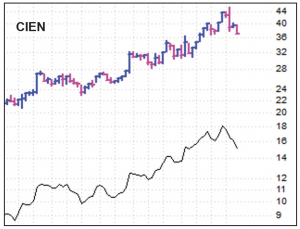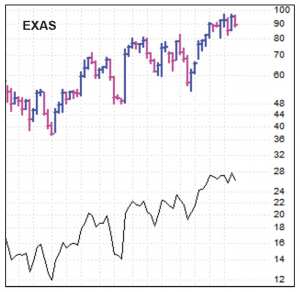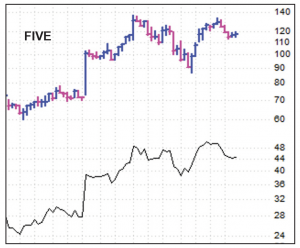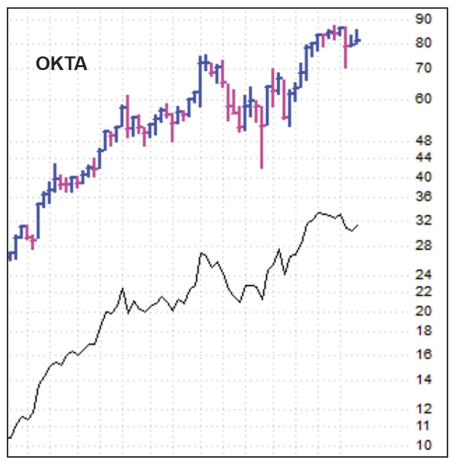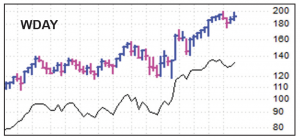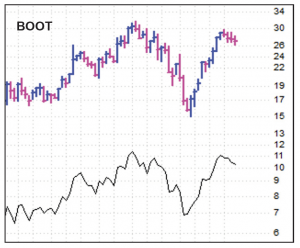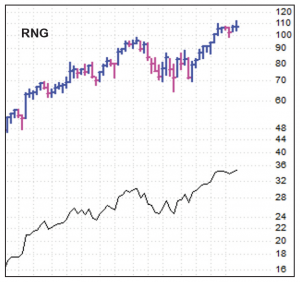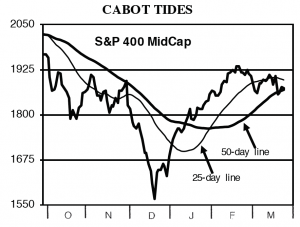Two weeks ago, we pointed out some developing divergences in the broad market, and in the short-term, those have caught up to the big-cap indexes and growth stocks, which have generally fallen off in recent days, including a couple of breakdowns. In the near-term, the outlook is still murky, so we advise stepping carefully, though big picture, we remain bullish and, hence, heavily invested.
In the Model Portfolio, we’ve placed some stocks on hold and, this week, sold one stock as it broke down on huge volume. We’re holding 18% cash now, though should the market and growth stocks firm up, we’ll be looking to put that to work in stronger leaders.
In tonight’s issue, we dive in deeper into all our thoughts on the market and our stocks, as well as look at prior environments after blastoff signals to see what’s normal and what’s not (hint: so far, we’re still in good shape).
Cabot Growth Investor 1416
[premium_html_toc post_id="173862"]
Short Term Remains Murky
Last week on this page we wrote that, while the longer-term outlook remained positive, we were starting to pick up on some cracks in the foundation—the broad market had stopped going up in late February and, despite a push to new highs for the popular big-cap indexes, the number of stocks joining the parade was thinning out, which made the short term a bit of a coin flip.
Well, that coin flip has come up tails, as selling in the broad market has spread elsewhere, knocking down all the major indexes and taking a bite out of many leading stocks. Moreover, our Cabot Tides are now on the fence—still technically positive, but another bad day or two could crack the intermediate-term uptrend that got started near the start of the year.
We always go with the evidence, and given the near-term wobbles and the potholes many growth stocks have hit, we’ve held off new buying, placed a couple of stocks on hold and, this week, sold one stock that cracked. We’re still heavily invested (18% cash) and holding our winners, but are being choosy on the buy side and tightening mental stops on poorer performers.
Going forward, the more important question is whether anything we’re seeing in the latest wave of selling is abnormal, possibly upending the longer-term bullish evidence? The answer: Nope, though we’re obviously keeping our eyes open.
Our Cabot Trend Lines, for instance, remain clearly bullish; it would take a couple of bad weeks for them to flip to negative. Leading growth stocks, while taking on water in recent days, mostly remain in uptrends. And a study we did this week on post-blastoff market action shows that the S&P 500 is acting normally thus far, portending higher prices down the road. (See page 6.)
Until proven otherwise, then, we still believe that the market etched a major low around Christmas, and that the first two-plus months of the year represent a kickoff to a new, sustained advance. Right now, though, the short term remains murky, so we’re watching where we step and waiting for things to firm up.
[highlight_box]WHAT TO DO NOW: Remain optimistic, but take things on a stock-by-stock basis. This week, we sold Exact Sciences (EXAS) due to its breakdown, and we’ve placed a few other names on hold. But we’re still mostly invested (18% cash) and, once this sloppy period is behind us, will be looking to reinvest into some new leaders.[/highlight_box]
Model Portfolio Update
As we write on page 1, the market has become more bifurcated over the past month. In the indexes, you can see that via the divergences between small- and mid-cap indexes, while most growth investors can see it in their portfolios, with some names still doing well but others dripping lower.
Throw in the fact that our Cabot Tides are on the fence and we’re respecting the change in the evidence by tightening stops on our losers and laggards, while sticking with stocks that are still acting well. In the Model Portfolio, we’ve ditched Exact Sciences after its abnormal breakdown yesterday and gone to hold on a few names.
However, just because we’re taking a little heat doesn’t mean we’re cowering—while we’re holding the cash from our sales at the moment, we’re starting to see some better entry points among leaders, but we want to see buyers make a stand (and our Tides to improve) before putting much money back to work.
Current Recommendations
BUY—Chipotle Mexican Grill (CMG 702)—CMG is off to a good start for us, as the tight post-earnings trading around 600 has led to a romp higher, bolstered by a positive earnings reaction from restaurant peer Darden and a handful of analyst upgrades and/or raised price targets. (Interestingly, though, is just one-third of analysts are positive on the firm’s shares—a positive from a contrary standpoint.) Obviously, after the straight-up move in recent weeks, a rest is possible (especially with round-number resistance near 700), but bigger picture, we’re viewing CMG’s action of the past three months similar to that of the market—it looks like a strong kickoff to a new, sustained advance, so barring a major change in the evidence (complete meltdown in CMG or the market), the odds favor higher prices over time. We’ll stay on Buy, but with the 25-day line way down around 638, try to buy on dips of 15 or 20 points if you don’t own any.
HOLD—Ciena (CIEN 37)—Being totally honest, we’ve come close to cutting bait with CIEN two or three times during the past week, but a couple of things have held us back. First, the stock is still clinging to support in the 37 area. Second, the stock has already been pulling back for a month, whereas much of the recent selling pressure has been seen in stocks that are extended to the upside. And third, of course, is that we see no change in the business, either story- or numbers-wise, so this seven-point pullback (after a 13-point advance from the market bottom) could easily be just a normal, albeit tedious, correction. All told, our stance with CIEN hasn’t changed much—we have a tiny loss on our combined cost basis, so we’ll hold on, but with a relatively tight stop below here.
SOLD—Exact Sciences (EXAS 85)—EXAS is a stock that looked like a real leader early on, with some bullish volume clues during the Q4 market meltdown and a breakout to new highs in late January, one of the first growth stocks to do so. But the past couple of months saw no real follow-through buying, along with lots of up-down-up-down action, which is a sign buyers and sellers are fighting it out. And then this week, we saw EXAS implode below its 50-day line and plunge to its lowest level in two months. Some of that may have been due to a report on another medical technology company that talked about some reimbursement risks (the entire med tech sector got walloped on Wednesday). One bad day could be acceptable, but when combined with the prior sloppy action, the break of support, our loss and the iffy market, we decided to cut our loss on a Special Bulletin Wednesday evening. We’re holding the cash and will redeploy it into a stronger name when the growth stocks firm up.
HOLD—Five Below (FIVE 130)—After a string of bad luck on earnings (most of our stocks got hit at least temporarily after their reports), Five Below scored a win after reporting its Q4 results last night. The numbers themselves weren’t anything out of the ordinary—sales rose 19% and earnings lifted 34%, both basically in-line with expectations—and the 2019 outlook was actually a bit below forecasts due to CapEx spending for new distribution centers and an accounting change. But big investors took comfort that, looking at the core business, nothing has changed—new store productivity remains best-in-class, management said the firm will be able to absorb the current 10% tariffs on Chinese imports, the new-store expansion remains on track (nearly 20% hike in the store count this year) and some new testing initiatives (store remodels, testing some $10 items) are bearing fruit. In other words, the underlying growth story is still intact, with 20%-ish sales and earnings growth likely for years to come, and given that the stock hasn’t done much in recent months after the latest correction, that was enough to bring in the buyers today. If you don’t own any, we’re not opposed to starting with a small position around here, but given that the stock is still stuck in the same range that’s contained it since last September, we’ll stay on Hold for a few more days and see if today’s strength sticks.
HOLD A HALF—Okta (OKTA 81)—OKTA remains a Hold if you own a half position like us, as the stock’s performance has been solid (crawling back toward its pre-earnings highs) but not great (no real buying volume and very choppy on a day-to-day basis)—in effect, the stock has been flopping around the 78 to 86 area for all of March. To this point, we’re viewing this as a normal rest period after a solid move in the first two months of the year, and the company’s leadership position in the identity access management sector should keep big investors interested. We’ll continue to play it by the book—a close in the mid 70s would have us selling our small holding, but above there, we’ll sit tight, and above 88 (with a stronger market) could have us averaging up.
BUY—Planet Fitness (PLNT 68)—PLNT has been hanging out in the 66 to 68 area for a couple of weeks, and some further consolidation wouldn’t be uncalled for given the big post-earnings advance and the cranky market. Barring a market-wide meltdown, though, there should be solid support on any dip of a few points, and bigger picture, we still love the potential here as Planet Fitness is taking a big share of the market—while the industry is being flooded with upscale and personalized gyms, this company is making hay by offering the basics for a low price, appealing to the mass market of gym goers. Back to the stock, we are keeping in mind the fact that PLNT has had a big move during the past couple of years, so it’s always possible big investors pull the rug and move to fresher situations. But we also know from history that successful cookie-cutter operations can often (not always) trend for a long time provided management continues to execute, which is what’s happening here. Long story short, sit tight if you own some, and if you don’t, you can pick up some shares here or (preferably) on dips of a couple of points.
BUY—ProShares Ultra S&P 500 Fund (SSO 116)—From the vantage point of the S&P 500, the market’s action thus far—even during its recent wobbles, the major index has dipped just a couple of percent from its recovery highs—has been nearly what you’d expect if we’re in a new bull trend. (See page 6 for more on what’s normal after blastoff indicators flash green.) That doesn’t guarantee anything, of course, as a Cabot Tides sell signal could usher in a deeper pullback; we could go to Hold if the Tides turn down or, if things get hairy, even sell a piece of our oversized position. But until proven otherwise, we’re still going with the evidence (a batch of new leadership, our bullish Cabot Trend Lines and the blastoff indicators in January and February) that points to the market having formed a major bottom late last year and is now in the early stages of a new bull phase. Hold on if you own some SSO, and if you don’t, we’re fine grabbing a position in this leveraged long fund (it moves twice the S&P 500, up or down, on a daily basis) here.
BUY—Twilio (TWLO 126)—TWLO remains quiet on the news front, but like a few of our stocks, has received some analyst love during the past two weeks, with one analyst talking about Twilio’s huge potential network effects (with a great chance of outpacing estimates for the next couple of years) and another analyst boosting his price target on optimism surrounding the company’s Flex offering, which is the first fully programmable cloud contact center platform. Of course, that hasn’t stopped the stock from taking on some water in recent days, but the action so far looks normal—volume has been average at best on the dips, and TWLO remains near its 25-day line (nearing 124 and rising). As with everything, a deeper correction is possible if the market comes under more intense fire, but the uptrend is intact and the story remains big. We’ll stay on Buy.
BUY—Workday (WDAY 190)—We went to Buy last week on WDAY, which wasn’t great timing—the market and growth stocks have basically been pulling back ever since, which has dragged the stock lower. Even so, we’re OK with the stock here, as it’s found support near its 50-day line, and remains basically in the middle of its range (175 to 200) of the past few weeks. Moreover, the stock is consolidating very reasonably following its big run over the past few weeks. We still see WDAY as a leader in the enterprise software group, which is one of the top growth sectors in the entire market—a drop back below its post-earnings low (175 or so) would be worrisome, but at this point, we’re holding our position, and think it’s OK to grab a few shares on this dip if you’re not yet in.
Watch List
Carvana (CVNA 58): We admit that CVNA doesn’t have the normal chart we look for—it’s had a big run but is still shy of its old peak—but we absolutely love this story (revolutionizing the used car business), the growth (triple-digit) and the stock’s recent resilience and volume clues.
LendingTree (TREE 348): We remain very high on LendingTree fundamentally (30% earnings growth expected both this year and next), and the recent decline in interest rates is likely to help its recently lagging mortgage business. But there’s still a lack of liquidity at times in the stock that gives us some pause.
Shopify (SHOP 203): SHOP is a leading stock again, with a strong, persistent run during the past three months and still-rapid sales and earnings growth. A deeper pullback wouldn’t be shocking to see, but if it comes, it could provide a nice entry point.
Tandem Diabetes (TNDM 64): We’re thinking TNDM is a glamour leader of this advance, with a blockbuster new product (its t:slim x2 insulin pump) that’s led to accelerating growth (sales up 89% in Q4), big fund buying (fund ownership has doubled in six months) and the potential is massive (it has just 2.5% of its U.S. market).
Xilinx (XLNX 127): XLNX continues to hover near its highs. We’re not thrilled with the year-ahead earnings estimates (up just 11%), but those are probably conservative given the accelerating sales and earnings growth in recent quarters.
Other Stocks of Interest
The stocks below may not be followed in Cabot Growth Investor on a regular basis. They’re intended to present you with ideas for additional investment beyond the Model Portfolio. For our current ratings on these stocks, see Updates on Other Stocks of Interest on the subscriber website or email mike@cabotwealth.com.
Arista Networks (ANET 312)—Arista Networks was one of the stars of 2017 as it took on Cisco with faster, better and more modern networking products for the new cloud- and data center-based world (a majority of new server shipments aren’t on-premise and most data center switching revenue is coming from cloud service providers). Indeed, while Cisco still has 49% of the high-speed data center switching market, that’s down from 69% in 2014, while Arista’s share is currently 17% and growing fast. It’s far from just hardware, though, as the company’s proprietary software makes the entire system work like a charm for clients. The details of the products can give you an ice cream headache, but they drove sales and earnings hugely higher during the past four years, which was the juice behind ANET’s big rally two years ago. That said, the stock didn’t do much for most of last year (the top was in February 2018) as growth slowed, but an estimate-beating Q4 report (sales up 27%, earnings up 32%) and some positive fundamental developments (releasing a new networking switch that was jointly developed with Facebook, putting itself in pole position to gain share with that giant) has the buyers back at it. Analysts see sales and earnings up just 17% to 20% or so this year, but the action of the stock says that’s low, as shares have powered back to its old highs in the 310 area. It’s not likely to be as big a mover as it was two years ago, but after a year-long period in the doghouse, it looks like ANET is back on track. A brief pullback or cooling-off period could provide a lower-risk entry point.
Boot Barn (BOOT 29)—Years ago, we remember when Tractor Supply (a one-stop shop for recreational farmers and ranchers) first came to our attention, and we practically giggled and wrote it off…only to then watch the stock enjoy a huge, steady multi-year advance! Today, those old biases are out the window, and we think Boot Barn could be the next retail winner that focuses on country living. The company is the leading firm that offers western and blue-collar work apparel—as its name suggests, footwear is its biggest category (a bit over half of revenue), but denim, rugged shirts, hats, belts and accessories are also big sellers. All told, it’s a $20 billion industry that’s very fragmented, is growing (thanks to both increasing blue-collar employment and wages, along with increased popularity of western culture) and, because it’s not fashion-oriented, price markdowns are a rarity. And management is executing very well—the firm had 234 stores at year end, with solid economics (payback of the initial investment in about three years), and believes it can at least double its store count over time (it’s been increasing the figure around 8% annually). Sales have been and are likely to continue growing in the mid-teens, with earnings expanding at a slightly faster clip. As for the stock, it’s a bit thinly traded for us ($30 million per day of volume), which can lead to some exaggerated moves, including its 50% haircut (32 to 15) during the market’s implosion late last year, and a snapback to 30 in the first two months of 2019. But the recent action is encouraging, with a modest, low-volume consolidation during the past month before perking up this week. If you want in, we advise starting with a small position and adding on a decisive push above 30 or 31.
RingCentral (RNG 107)—There’s a revolution going on with business communications given the nature of how workers are getting in touch with each other—gone are the days of people sitting at their desk and answering their landline, replaced by mobile, message and multimedia talks and meetings. RingCentral’s cloud-based platform is a leader in a new field called Unified Communications (UC), which is allowing employees and entire teams to get together at any time and from any device. It’s a simple story, but the runway of growth could be immense, as the company estimates that just a few million workers in the U.S. are using a new-age UC platform, compared to 100 million potential customers, and RingCentral is about twice the size of its nearest competitor. Not surprisingly, the firm has posted excellent and consistent growth for a while (revenues have risen between 30% and 35% each of the past eight quarters), while profits have been expanding at an even faster rate. Our biggest rub is that the stock had a big, big run in 2017-2018, so there’s always the chance the buyers run out of ammo (i.e., that the stock is in the later innings of its run). But there’s certainly no sign of that now—in fact, RNG’s reasonable correction late last year, nine-week run to new price and RP peaks in January/February and its relatively tight consolidation over the past month all look bullish. We’re not opposed to starting a position here or on dips of a few points.
Tame Pullbacks are the Norm After Blastoff Signals
We’ve written a fair amount about the blastoff indicators that flashed in January and February, including two tried-and-true measures—the 2-to-1 Blastoff Indicator (which flashed a Buy signal in early January) and the 90% Blastoff measure (which turned green February 20)—that have great records of portending higher prices in the months ahead.
That said, we always like to “trust, but verify,” which is why we put most of our emphasis on our market timing indicators and the action of our stocks—it’s what’s happening now that counts most. No matter the indicator, there are no guarantees in the market.
With that in mind, we dug a bit deeper to see what was “normal” action following green lights from these indicators. One thing that stuck out—the big-cap major indexes rarely pulled back very much after these signals, at least for a couple of months.
For instance, let’s look at the 90% Blastoff Indicator, which, before this year, had given a Buy signal just 11 times since 1970. (Hat tip to The Chartist’s Dan Sullivan, who came up with the indicator years ago.) It turns out if you bought the S&P 500 at every one of these 90% signals since 1970, your average maximum loss from that price during the next few months was a mere 1.5%. By comparison, the maximum loss so far from this year’s 90% signal is 2.2%, basically in line with what you’d expect.
There was one outlier—back in 2016—when the unexpected Brexit election result saw the S&P sink like a stone for two days, falling nearly 5% below the 90% signal from a couple of months before. However, even that loss was quickly recouped over the next few days as the market snapped back. Translating this data to 2019, it looks like a close much below 2,675 to 2,700 in the S&P (3% to 3.5% below the 90% signal from February 20) would be a bit unusual when it comes to these signals.
Another factoid: For just about all these signals (2-to-1 or 90%), the market didn’t break its 200-day line for many months down the road, if at all. (For some signals, like the one in 2009, it took a few weeks for the indexes to finally rise above their 200-day lines—but once they did, they never decisively fell back below it.) Given that the S&P’s current 200-day line is near 2,750 and providing some wiggle room, this would also line up with the 2,700 level, give or take.
Don’t get us wrong, we’re not trying to put too much emphasis on a specific level from just one major index as the market doesn’t deal in exacts. Even if we did see a sharp retreat (like the one in 2016), it doesn’t mean the market is going to fall apart. It’s more about the general idea that, almost uniformly, these blastoff signals led to only modest pullbacks and rarely dove below long-term moving averages over the short haul.
To us, this sets up a good test during the current dip. Should the major indexes begin to melt away, for instance, it would be a red flag that, for whatever reason, these blastoff signals may not carry the same weight (and produce the same positive results) this year. That said, we always go with the evidence in front of us, and to this point, the market is acting just as you’d expect—rising with only—brief, minor dips. So far, so good, but it’s worth monitoring.
How We Practice Diversification
We never write much about diversification because, frankly, we don’t subscribe to it all that much—we run a relatively concentrated portfolio (10 to 12 positions when fully invested) and it’s not unusual for us to have 15% or 20% in a stock if it’s a big winner.
Still, that doesn’t mean we don’t try to spread things around. In our experience, the best way for a growth investor to do that is (a) to make sure not to get overexposed to any one sector, and (b) to diversify between well-traded names and so-called glamour stocks.
The first point is self-explanatory. You don’t need to own five cybersecurity stocks, for instance; if you’re going to do that, try to find a sector fund you can own instead. Rather, we suggest honing in on the one or (maybe) two top leading stocks in the group.
The second point is a bit harder to define, but it’s really about making sure you don’t own all “fastballs”—very volatile, sometimes thinner and faster-moving stocks that, when growth stocks get hit, can quickly drop (or break down). Usually having a few well-sponsored liquid leaders along with a few potential home runs is a better plan, allowing you to make great money in good times and keep your wits about you when the sellers take control.
Cabot Market Timing Indicators
Most of the evidence still points to higher prices when looking down the road, but the near-term looks trickier—the intermediate-term uptrend is on the fence and some growth stocks have wobbled. We’re still bullish overall, but are tightening some stops and keeping a close eye on things.
Cabot Trend Lines: Bullish
Our Cabot Trend Lines are still in the bullish camp, as both the S&P 500 (by 1.9%) and Nasdaq (by 2.8%) closed above their 35-week moving averages. Granted, those moving averages themselves are basically trudging sideways, so we’re not in a powerful longer-term uptrend (yet), but the fact that the Trend Lines are positive continues to tell us that the odds favor higher prices in the months ahead.
Cabot Tides: On The Fence
The market’s had a great run from last year’s lows, but now the intermediate-term trend is up in the air. Our Cabot Tides are on the fence as two indexes are at or below their lower (50-day) moving averages (including the S&P 400 MidCap, shown here) and the other three are getting close. As usual, we don’t anticipate signals, so right now, the trend is still pointed up—but the next few days will be telling to see whether the market is in for a correction, or whether buyers will again step up to the plate.
Cabot Real Money Index: Neutral
Our Real Money Index remains in neutral territory, so there’s officially no short-term edge (bullish or bearish) seen from money flows. That said, it’s clear the market’s latest hiccup caused some worry—today’s update saw $11 billion yanked from equity funds and ETFs last week alone, a relatively large figure. It’s an anecdotal sign that there’s plenty of skittishness out there, which is a plus.
[premium_html_footer]
Send questions or comments to mike@cabotwealth.com.
Cabot Growth Investor • 176 North Street, Post Office Box 2049, Salem, MA 01970 • www.cabotwealth.com
All Cabot Growth Investor’s buy and sell recommendations are made in issues or updates and posted on the Cabot subscribers’ website. Sell recommendations may also be sent to subscribers as special bulletins via email and the recorded telephone hotline. To calculate the performance of the portfolio, Cabot “buys” and “sells” at the midpoint of the high and low prices of the stock on the day following the recommendation. Cabot’s policy is to sell any stock that shows a loss of 20% in a bull market (15% in a bear market) from our original buy price, calculated using the current closing (not intra-day) price. Subscribers should apply loss limits based on their own personal purchase prices.
Charts show both the stock’s recent trading history and its relative performance (RP) line, which shows you how the stock is performing relative to the S&P 500, a broad-based index. In the ideal case, the stock and its RP line advance in unison. Both tools are key in determining whether to hold or sell.
THE NEXT CABOT GROWTH INVESTOR WILL BE PUBLISHED APRIL 11, 2019
We appreciate your feedback on this issue. Follow the link below to complete our subscriber satisfaction survey: Go to: www.surveymonkey.com/marketlettersurvey
Neither Cabot Wealth Network nor our employees are compensated by the companies we recommend. Sources of information are believed to be reliable, but are in no way guaranteed to be complete or without error. Recommendations, opinions or suggestions are given with the understanding that subscribers acting on the information assume all risks. © Cabot Wealth Network. Copying and/or electronic transmission of this report is a violation of U.S. copyright law. For the protection of our subscribers, if copyright laws are violated, the subscription will be terminated. To subscribe or for information on our privacy policy, call 978-745-5532, visit www.cabotwealth.com or write to support@cabotwealth.com.
[/premium_html_footer]




